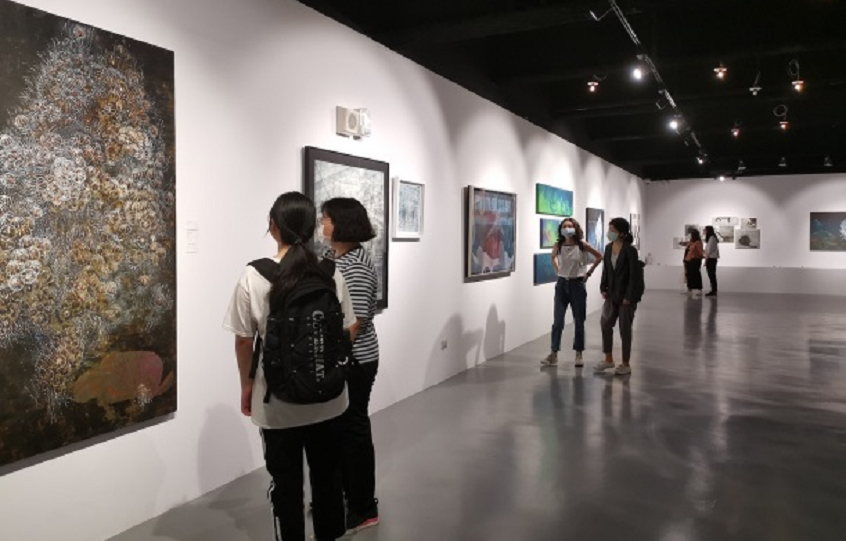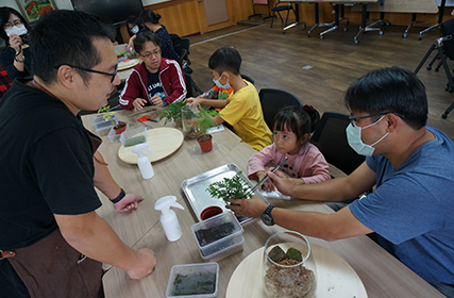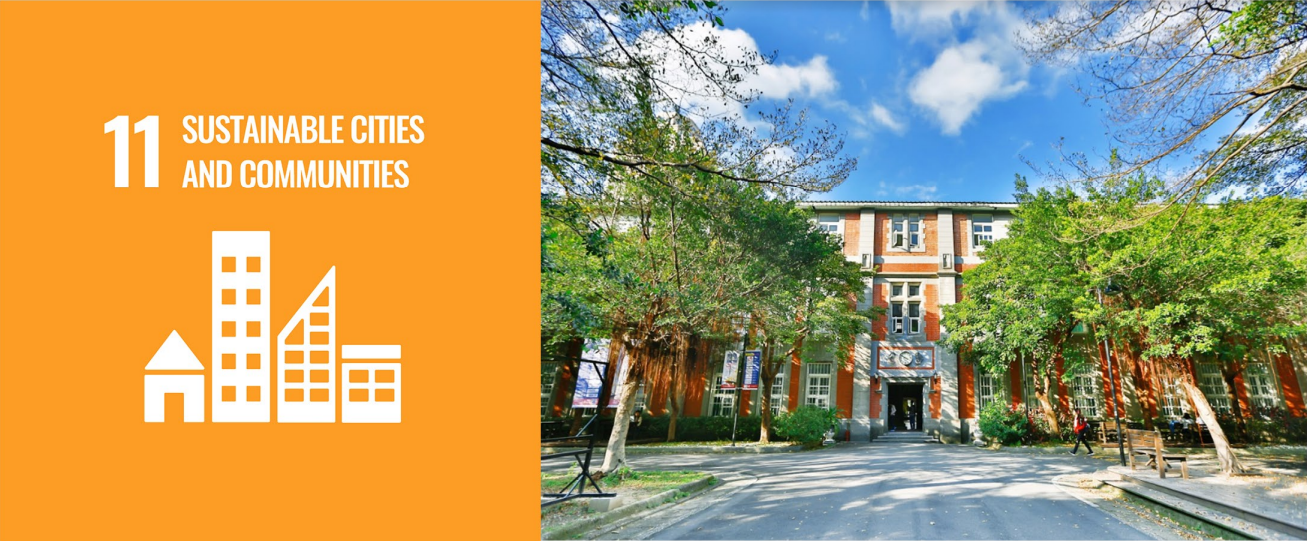
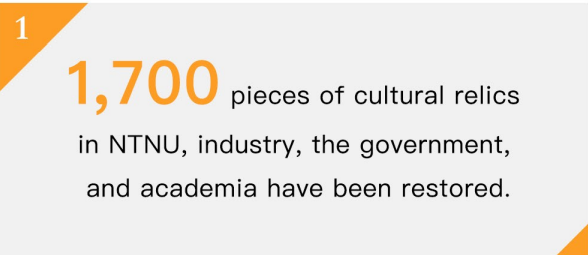
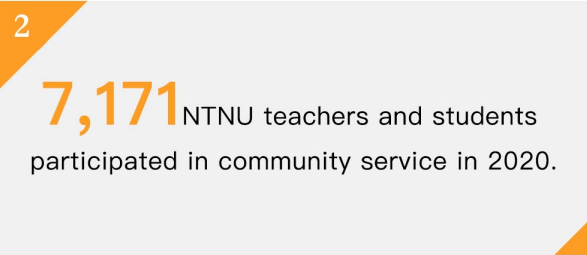
11.1 Spirit of the SDG and the University’s Philosophy
SDG 11 expects countries around the world to focus on creating a suitable environment for the lives of all ethnic groups in cities, and specifically mentions that the ability of cities to respond to negative environmental impacts and disasters should be improved. In terms of overall institutional governance, the University actively promotes an institution-wide social practice plan, enhances the connection between itself and the community, and organizes various activities in conjunction with courses related to university social responsibility (USR) to increase the opportunities for teachers and students to interact with the people in local communities. At the community level, the University has planned and promoted the “University Way: Low-Carbon Green Energy Pathway” project, so that the education programs that it provides have the characteristics of safety, comfort, efficiency, carbon reduction, green energy, and cultural economy. Community recreational bicycle trails contribute to sustainable development both locally and globally. At the national level, through policy implementation and academic research, the resources of industry, the government, and academia are connected to assist national and regional development plans. On the international front, the University participates in international conferences related to sustainable development, communicates with experts on sustainable development issues and promoting international cooperation, establishes global partnerships for sustainable development, and thereby demonstrates that Taiwan is an important partner in the implementation of sustainable development in the world.
11.2 Achievements
11.2.1 Constructing community-based civic practices and innovative services
The University is actively expanding into diverse service fields, leading teachers and students to enter the community for providing services. In 2019, it began to promote community-based civic practice and service learning courses, providing 84 classes in which 2,452 students took courses. Practical topics included services for the elderly, community building, food and agriculture education, citizen journalists, reducing environmental levels of PM2.5 and plastics, digital remote teaching, and design thinking. Being involved in implementing services in multiple areas will make students more aware of social issues, cognitive understanding, and SDG literacy. Through the process of community investigation, preparation, action, reflection, display, and celebration, students are guided to collaborate with community partners to achieve the goal of mutual benefit with the community.
The University additionally has provided long-term assistance to the development needs of local schools and districts. It has jointly implemented the long-term care of the elderly, and for physical and mental health and leisure-related living concepts in 12 districts and 5 neighborhoods and churches in Taipei City, in 4 districts in New Taipei City, in high schools and churches, Taipei United Hospital, Bali Nursing Home, in 6 long-term care centers in Wanhua and Daan Districts, with the Republic of China Family Caregiver Care Association, Taiwan Association of Counseling and Counseling, and Lotus Foundation. The University is cooperating with Guting Market (which is near the campus), 19 businesses on Shida Road, community youngsters’ and children’s stations, Shiding District schools, and cultural and historical work teams to promote environmental literacy in plastic reduction and water conservation.
11.2.2 Being friendly to the arth and build a sustainable and smart campus
The University signed the Talloires Declaration (“NTNU Towards a Green University Commitment”) in May 2009, and won the “Excellent School” award in the 2017 Excellent Green University Selection. The concept of green universities has been incorporated into the University’s development policy, to produce short-, medium-, and long-term teaching and research development plans, and gradually implement them in teaching, research, USR, and international connections, and leading teachers and students to learn together. The concept of sustainable environmental protection has been incorporated into the design of green buildings, so that the processes of planning, designing, constructing, using, maintaining, and then finally dismantling buildings can be achieved with the benefits of energy saving, resource saving, low pollution, and low waste, and thereby transform the campus environment into a community characteristic public activity space. The certified buildings at NTNU include the International Conference Center, the student dormitories of the Gongguan campus, and the NTNU Art Museum, which received the silver-, silver-, and bronze-level green building marks, respectively.
11.3 Featured Highlights
11.3.1 Cultural heritage protection and research
The “Cultural Relics Preservation and Maintenance Research and Development Center” was officially opened on October 22, 2011. NTNU is the first national university in Taiwan to set up a restoration center. This center has integrated humanities and arts, restoration aesthetics, restoration techniques, and modern technology across different fields to form an elite team that has completed the restoration of many national important collections of cultural relics, such as the National Museum of History Zhang Daqian’s paintings and the manuscripts of Taiwan’s first female painter Chen Jin. There were 90 collections restored in 2020. This center became the first university member state to join the “Infrared and Raman Users Group” (IRUG), who together have cooperated to promote the IRUG-NTNU International Infrared and Raman Technology Analysis User Organization-Cultural Heritage Science Research and Database Project. Since 2017, 177 Raman maps and 119 infrared spectra have been obtained, and the University continues to move towards the establishment of a database of historical materials of cultural relics in the Greater China region.

The “Music Digital Collection Center” of NTNU was established in September 2004, and in 2010 officially became a university-level center. It is the first center in Taiwan to develop music collections, and is dedicated to the digital preservation of Taiwan’s precious music documents, paintings (including paper documents), and audio documents. With the aim to promote the preservation of precious music documents, it has completed more than 30 collection projects of Taiwan’s precious music documents, including 15 large-scale digital collections of national science and technology projects, with remarkable results. It is worth mentioning that the Swiss priest Alois Osterwalder (1933~) alone funded Shi Weiliang (1925~1977) to promote Taiwan’s folk song collection movement, and the 56 volumes of tapes left behind were able to return to Taiwan thanks to the selfless permanent loan made by Father Osterwalder. To commemorate Father Osterwalder’s dedication to safeguarding Taiwan’s cultural assets, the NTNU Music Digital Collection Center has organized international lectures and seminars under the name “Osterwalder Lectures” since 2013, and has promoted international exchanges and dialogues between technological and business professionals in a cross-cultural manner in an attempt to encourage more social elites to become involved in cultural heritage preservation.
Related Media Coverage
11.3.2 Creating art with local characteristics and enhancing the national artistic spirit
The University demonstrates the effectiveness of learning via multiple activities, allowing art to enter the mainstream, and striving to integrate art and life. Public exhibitions and performances are held each year, which not only energize the surrounding communities of NTNU, but also demonstrate the specific practice of USR. In 2020 there were 118 art exhibitions and 25 music and theater performances held, with more than 15,000 participants. Every spring and summer, the National Taiwan Normal University Art Festival and National Taiwan Normal University Music Festival are major annual events of NTNU that integrate art, music, design, performance, and other different art forms, presenting the new atmosphere of NTNU’s art and music creation. Members of the community and other neighbors are invited to participate in the grand event, which also creates a beautiful artistic and cultural atmosphere for the community.
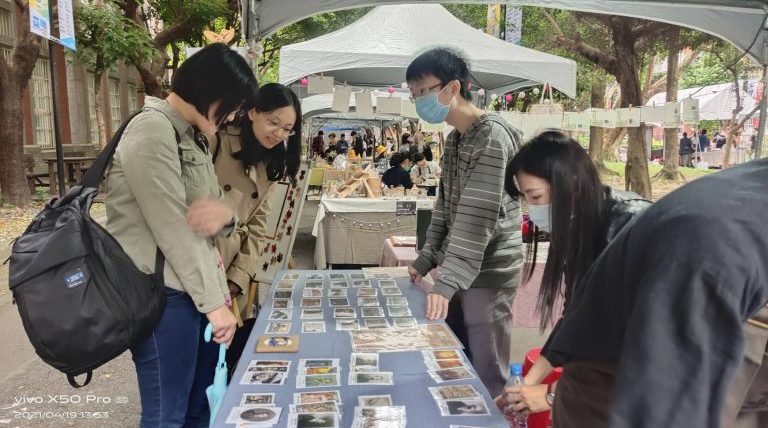
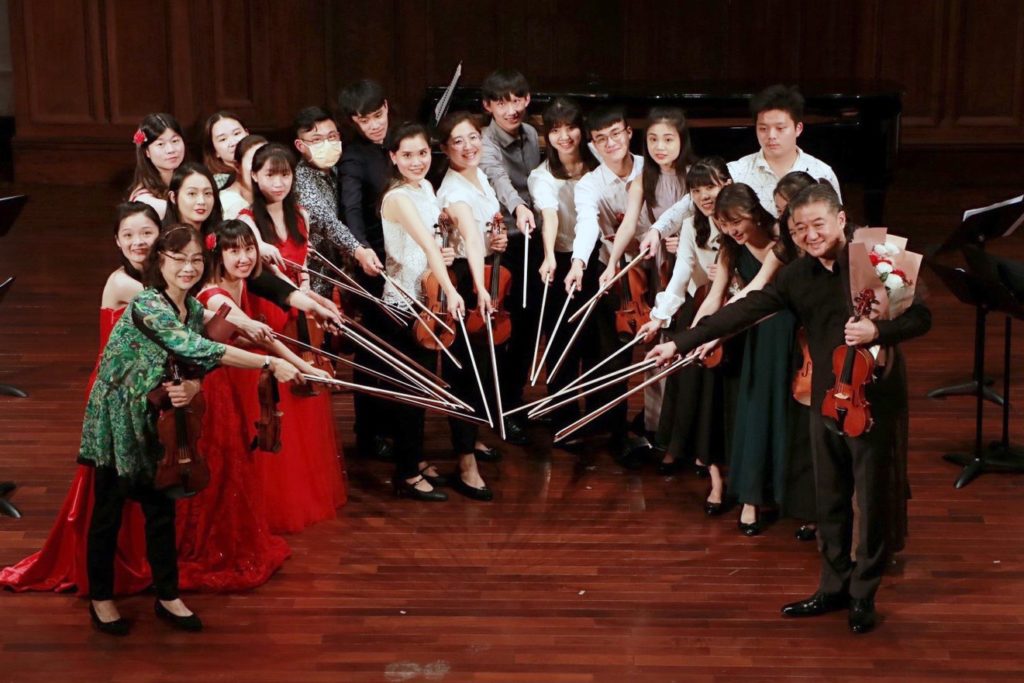
11.3.3 Launched a community building project centered on the NTNU Art Museum
The NTNU Art Museum was completed in 2018, at which exhibition and education promotion functions are held. The museum received a public art subsidy from the Cultural Affairs Bureau of Taipei City Government in 2020 entitled “2020 Art Scattering Plan in the Name of Trees-Launching a 21st Century Urban Ecological Art Museum,” starting from the concept of an “Eco Art Museum,” and planning day readings and guidance of the neighborhoods around the art museum. Temporary public art works were set up in Jin’anli and Long’anli to build friendly relationships between the art museum and the neighborhood. Eleven community-experience workshops have held, with more than 300 people participating actively. In addition, a series of events including 18 scheduled (fixed) guided tours, 10 temporary works of art, and 9 collections of the University will be held.
